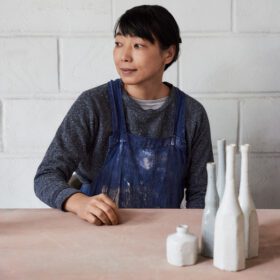Akiko Hirai was born in Japan in 1970. She moved to London in 1999, studying ceramics at the University of Westminster and Central St. Martins. Akiko’s work is both a blend of Japanese and British studio pottery traditions resulting in asymmetrical, ‘imperfect’ organic forms.
‘Junichiro Tanizaki (1886-1965) talked about Japanese aesthetics in architecture, crafts, food and art in his book ‘In Praise of Shadows’.
“The quality that we call beauty must always grow from the realities of life, and our ancestors, forced to live in dark rooms, presently came to discover beauty in shadows, ultimately to guide shadows towards beauty’s ends.”
It was published in 1933. Because of the change of our lifestyle due to the development of technology, people travel long distances easily and the amount of information that we can access is far greater than a decade ago, I feel some of Tanizaki’s statements are perhaps not relevant to our present lifesytle, however, I feel my application of art, design and craft are still strongly based on the aesthetics he described in the book; such as indirect expression of objects and the art of impermanence.
When I make my ceramic ware, I pay more attention to the ‘signs’ of events that happened in the process. It can be a cracked surface that was pulled by the expansion and contraction of the material on the ceramic surface, the unevenness of the colour due to the change of atmosphere in the flame in my kiln, the impurity of the material that comes through to the surface in high heat etc. You think you are looking at the outcome of the events but what we are seeing is not the results of the objects but the forces that create these marks. This is the same mental process of looking at the shadow in order to enjoy the light.
During the process of mass production, commercial tableware are made in the conditioned environment that minimizes theses events and uneven forces. Thus, they have perfect consistency and stillness as domestic objects. This approach is economical and rational, however it can take the life away from the objects. There are no shadows that appear and disappear every time you look at it. There is only a fluorescent light permanently lit upon the object.
I am showing a variety of objects in this exhibition, from vigorously textured Moon Jars to small cups. They are all made with one principal in mind; in praise of shadows.’
Akiko Hirai, 2017



